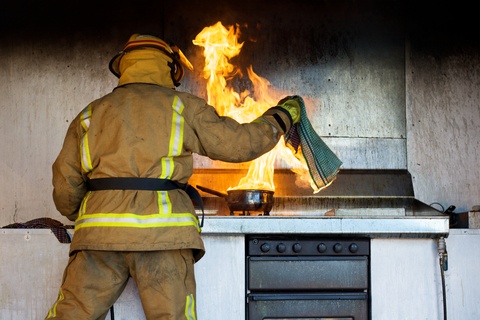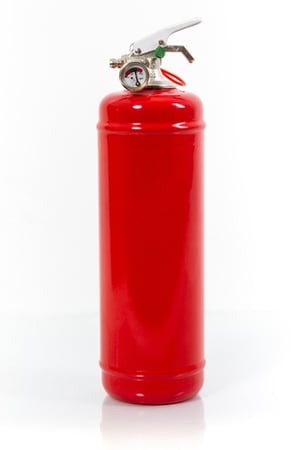.png?width=560&name=The%20rustic%20kitchen%20(1).png)
Many lung conditions, such as COPD, asthma, cystic fibrosis and pneumonia can all require the use of supplemental oxygen.
Supplemental oxygen can pose a risk for those who are cooking as it can cause any flames to increase in size and temperature.
Though oxygen will not combust, if exposed to fire, it can cause the fire to get worse a lot quicker and can then result in a total house fire.
Oxygen does not cause fires, but it can feed the fire and cause it to grow.
It can be risky for those on oxygen to cook with their oxygen unless they have taken the appropriate measures.
Preparing for Cooking:

Before you start cooking, it is important to prepare your home to lower the risk of fires, and to make it known if there is a fire.
It is very important to have a smoke detector that is working and up to date.
Smoke detectors should be replaced every 10 years and should be tested once a month according to the U.S. Fire Administration (USFA).
The batteries should be replaced once or twice a year, and it is important to test the batteries throughout the year to make sure they have enough battery life.
Smoke alarms should be placed on every floor of the home and in hallways, near bedrooms and any sleeping areas.
This allows those who may be sleeping to hear the alarm going off and evacuate the home if needed.
You also will need a fire extinguisher in your home, depending on your common areas, you may need multiple fire extinguishers.
It is recommended to put a fire extinguisher on every level of the home, near/in every bedroom, and in the kitchen, laundry room and the garage.
By keeping the fire extinguishers in easily accessible locations, it can make it easier for anyone in a house fire situation to grab one and hopefully put out or slow down the fire.
In order to prepare your local fire department and your electrical company in the event of a fire or power outage, you should notify them of your oxygen use.
It is also important to inform your fire department and local electrical company that you are on oxygen (and inform them if you keep your unit plugged in).
By letting your fire department know that you are on oxygen, they may check on your first or have a better response time if there are reports of a fire or even just for a wellness check.
Your local electricity company should know about your oxygen use, as they may lower your rate if your unit is plugged in constantly.
They may also make your home a priority in the event that power is lost in your neighborhood, it may be beneficial to buy a backup generator for your home as well.
If there were to be a severe power outage, a backup generator will help your machine keep running until power is restored.
Having a power cord to charge your unit in your car may also be beneficial to have in case of a power outage or any emergency.
O2 and Cooking:
During your cooking experience, it is important to keep any supplemental oxygen away from your stove, and oven.
If a fire were to start, your supplemental oxygen can cause the fire to worsen, as pure oxygen is an accelerant for fires.
You also need to avoid any splattering grease while cooking, as it can catch fire and your O2 can worsen the fire.
Any flammable liquid or aerosols should be kept away from the stove and oven as well, as any close contact can cause a fire or explosion.
Leaving those chemicals under the sink and away from flames a good place to keep them, as they are closer to water if anything does catch on fire.
Though loose clothing may be more comfortable, wearing it while cooking can be a hazard and is not recommended.
Any spark or flame to reach your clothing can start a fire, and as many oxygen users wear cannula, it can catch on fire and possible cause skin burns.
As for your cannula, in order to prevent it from getting it your way or getting caught on something, try to run your cannula down your back versus hanging in front of you.
When cooking, make sure your cannula is never hanging in front of you and keep your supply of oxygen away from the cooking surface.
Some people chose to get extended tubing to allow the oxygen source to be in an entirely different room from where they are.
Remembering to keep your source of oxygen roughly 5-10 feet away from any source of fire, so a stove, oven, fireplace or even something as small as a candle.
During Cooking:
 It is important to keep the fire extinguisher in the kitchen easily accessible while cooking.
It is important to keep the fire extinguisher in the kitchen easily accessible while cooking.
While you are cooking, take your time and keep everything clean and organized.
By cooking at a slower pace, there is less room for any mistakes that can end in a kitchen or home fire.
A slow pace can make it easier on you to clean and not feel too rushed while trying to cook.
By keeping your kitchen clean and organized while you cook, it allows for you to see everything and avoid any spills or messes that may be flammable.
A clean kitchen can also make clean up after cooking easier on your lungs and your body.
Cleaning as your cooking, say you are letting ground beef brown and while that browns you are cleaning up any spices or ingredients you may have used, can make it easier for you and reduce the time in the kitchen.
The easiest way to cook while on oxygen is to try a slow cooker, as they are an easy and safe way to get tasty home cooked meals without as much effort or dishes.
Most importantly during cooking, try to stay cool near the warm oven or stove, as the heat can make you feel too hot and tired.
Conclusion:
Though cooking with supplemental oxygen may seem like an impossible task, it is not very hard when you take your time.
By preparing your home for a possible fire, you are taking steps towards a safer home.
Keeping an up to date smoke alarm and fire extinguisher on every level of your home, you are able to be ready for a possible fire.
Taking your time while cooking, and cleaning as you go can also make your cooking process safer and easier for yourself.
Overall there are not too many precautions needed in order to cook at home, but it is very important to make sure your smoke alarms and fire extinguishers are up to date in case a fire does occur.



